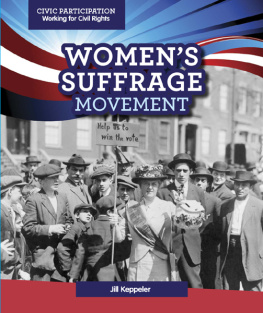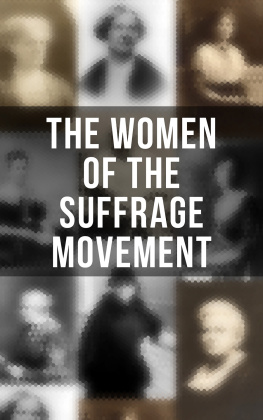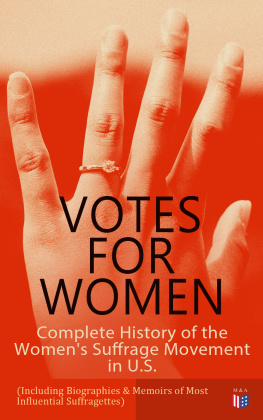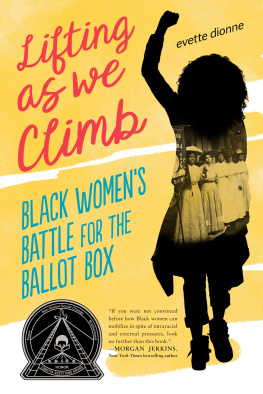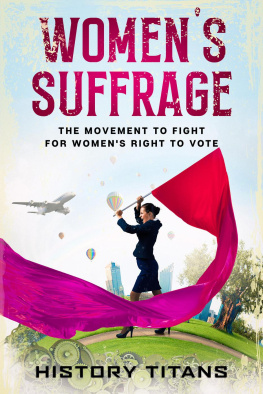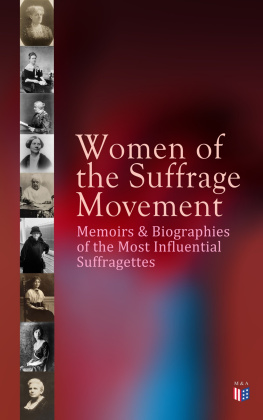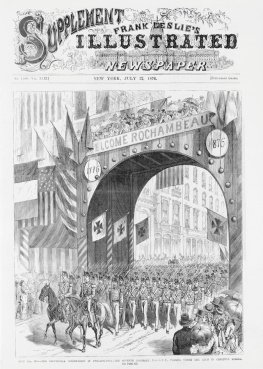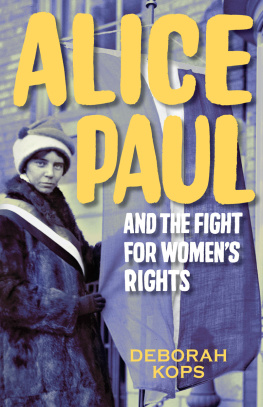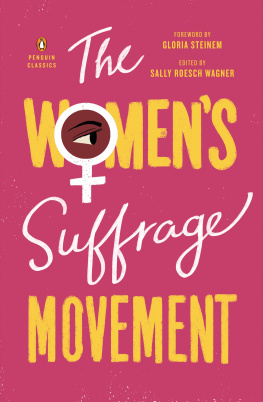
Published in 2017 by The Rosen Publishing Group, Inc.
29 East 21st Street, New York, NY 10010
Copyright 2017 by The Rosen Publishing Group, Inc.
All rights reserved. No part of this book may be reproduced in any form without permission in writing from the publisher, except by a reviewer.
First Edition
Editor: Caitie McAneney
Book Design: Mickey Harmon
Photo Credits: Cover (image), pp. 5, 7, 13, 15, 21, 23, 25 Everett Historical/Shutterstock.com; cover, pp. 1, 332 (background) Milena_Bo/Shutterstock.com; p. 6 Print Collector/Contributor/Hulton Fine Art Collection/Getty Images; p. 9 (Truth) MPI/Stringer/Archive Photos/Getty Images; p. 9 (Mott) Time & Life Pictures/Contributor/The LIFE Picture Collection/Getty Images; pp. 9 (Stanton),11, 15, 17, 27 Bettmann/ Contributor/Bettmann/Getty Images; p. 19 Buyenlarge/Contributor/Archive Photos/Getty Images; p. 29 NurPhoto/Getty Images.
Cataloging-in-Publication Data
Names: Keppeler, Jill.
Title: Womens suffrage movement / Jill Keppeler.
Description: New York : PowerKids Press, 2017. | Series: Civic participation: working for civil rights | Includes index.
Identifiers: ISBN 9781499426854 (pbk.) | ISBN 9781499428452 (library bound) | ISBN 9781499426861 (6 pack)
Subjects: LCSH: Women--Suffrage--United States--History--Juvenile literature.
Classification: LCC JK1896.K47 2017 | DDC 324.6230973--dc23
Manufactured in the United States of America
CPSIA Compliance Information: Batch #BW17PK: For Further Information contact Rosen Publishing, New York, New York at 1-800-237-9932
CONTENTS
CREATED EQUAL
We hold these truths to be self-evident, that all men are created equal.... Those are some of the most famous words ever written in the history of the United States of America. However, author Thomas Jefferson left out something rather importantwomen.
This line from the Declaration of Independence set the stage for freedom for all Americans, but even after the American Revolution, it was clear that some people had more freedoms than others. The women of the United States had to fight for years to gain suffrage, or the right to vote in elections. These brave pioneers endured legal challenges, harsh criticism, and sometimes even physical abuse.
Today, thanks to the womens suffrage movement, all women in the United States have the right to vote. Women also hold some of the nations highest political offices.
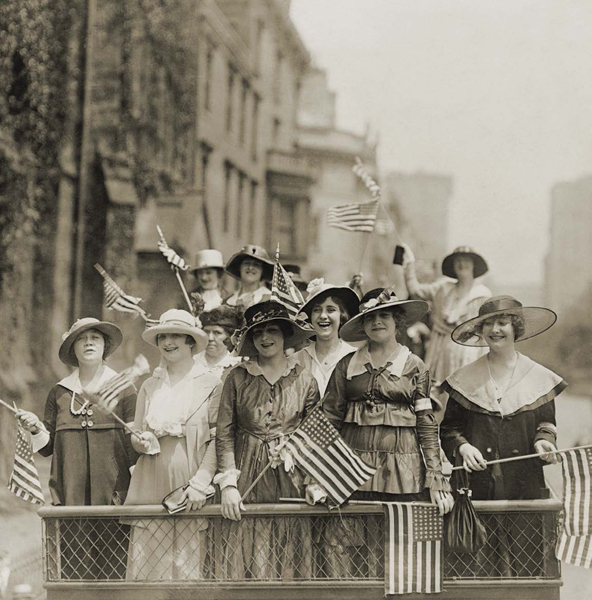
The women who fought for the right to vote in the United States were very brave. Many people thought they should not have this right, but they kept fighting.
SETTING THE STAGE
The fight for womens suffrage in the United States grew from a larger struggle for womens rights. In the early days of the United States, there were many stereotypes and expectations about womens place in society. Many people believed that women were only supposed to be involved in domestic concerns.

An Early Leader
Women in Great Britain began fighting for the right to vote around the same time the suffrage movement in the United States began. In 1792, a British woman named Mary Wollstonecraft published A Vindication of the Rights of Women. Wollstonecraft was one of the first to call for suffrage for women. She also said the educational systems of the time trained women to be helpless and that women and men should receive equal educations.
However, many American women began to reject the idea that their only true purpose was to be wives and mothers who were only concerned with the home. They were interested in being a real part of society and making a difference. In the 1800s, there were many reform groups whose members wanted to change society for the better. Many American women wanted to be involvedand to be taken seriously while they did so.
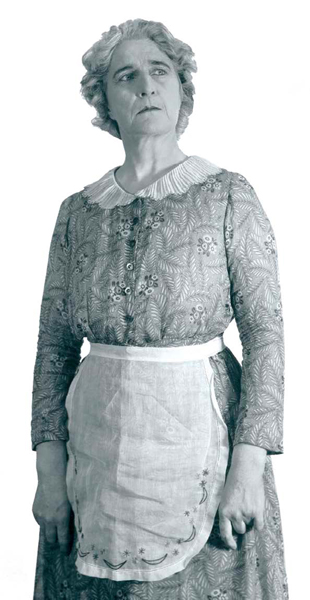
Many women who wanted the right to vote were wives and mothers. They wanted to be respected as people with minds and goals too.
ANOTHER FIGHT FOR FREEDOM
Some of the women who would lead the U.S. womens suffrage movement were first involved in the abolitionist movement, which sought to end slavery in the United States. However, some abolitionist groups didnt accept female members and the ones that did often kept women out of leadership roles. Sisters Angelina and Sarah Moore Grimk were criticized because they made speeches against slavery to groups that contained both men and women.
In 1840, abolitionists Lucretia Mott and Elizabeth Cady Stanton traveled to London, England, for the World Anti-Slavery Conventionbut they and other women were forced to watch instead of actually taking part. Mott, Stanton, and many other women came to the conclusion that, to be taken seriously as reformers, they first needed the right to vote.
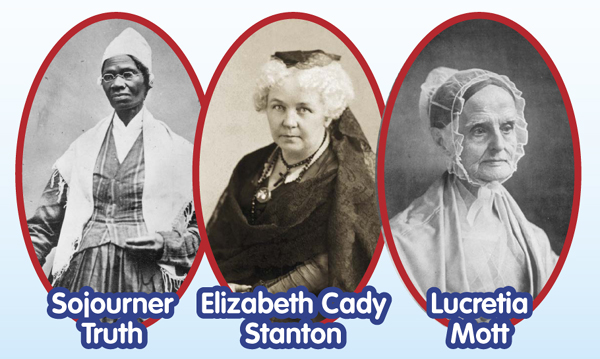
Before they fought for womens suffrage, these leaders of the womens suffrage movement fought to end slavery.
A Powerful Speaker
Sojourner Truth, born Isabella Baumfree, fought for both abolition and womens suffrage. She was born into slavery around 1797 in New York State and escaped in 1827. Truth joined the abolitionist movement in the 1840s and the womens suffrage movement in the 1850s. She may be best known for a speech she delivered in 1851. This speech, which came to be known as Aint I a Woman?, showed the struggle of being both black and a woman.
COMING TOGETHER
Many people mark the beginning of the U.S. womens suffrage movement as July 1848, when the first womens rights convention took place in Seneca Falls, New York. More than 200 people attended the event, which Lucretia Mott and Elizabeth Cady Stanton organized.
During the convention, Stanton read a Declaration of Sentiments that outlined the rights that women should have. It included the line We hold these truths to be self-evident, that all men and women are created equal.... Of those who attended, 100 people signed it, including 68 women and 32 men.
The convention also produced a dozen resolutions, one of which called for womens suffrage. The resolution concerning the right to vote was very controversial. Many thought it should be removed, but Stanton argued in its favor. The resolution stayed.

In this illustration, Elizabeth Cady Stanton speaks at the 1848 womens rights convention. In 1998, Seneca Falls hosted a celebration marking the 150th anniversary of the convention. Hillary Clinton spoke atthe event.
After the Seneca Falls convention, organizers started to plan many more womens rights conventions. The first National Womens Rights Convention took place in October 1850 in Worcester, Massachusetts. It was organized by Paulina Wright Davis and other suffragists, or people working for voting rights.
The event featured debates, speakers, and plans for the future of the movement. More than 1,000 people attended. While participants talked about many topics, suffrage was a main focus. For some time after this, national womens rights conventions were held every year.
Next page
